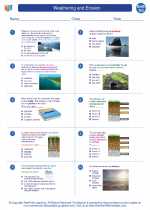Convection Currents
Convection currents are a type of heat transfer that occurs in fluids (liquids and gases). They are driven by the movement of the fluid due to differences in temperature and density. Convection currents play a crucial role in various Earth processes, such as the movement of magma in the mantle, the circulation of the atmosphere and the oceans, and the transfer of heat within the Earth's interior.
How Convection Currents Work
Convection currents are driven by the differences in density that result from variations in temperature within a fluid. When a fluid is heated, it becomes less dense and rises, while the cooler, denser fluid sinks. This creates a continuous cycle of movement, with the warmer fluid rising and the cooler fluid sinking.
In the Earth's mantle, for example, heat from the Earth's core causes the rock to become molten and less dense. This molten rock rises towards the surface, where it cools and becomes denser, eventually sinking back down. This process of rising and sinking creates the slow, but steady movement of the Earth's tectonic plates.
Importance of Convection Currents
Convection currents are crucial for redistributing heat within the Earth and its atmosphere. They play a key role in driving the movement of tectonic plates, which leads to the formation of mountains, earthquakes, and volcanic activity. In the atmosphere, convection currents contribute to the formation of weather patterns and the global circulation of air.
Studying Convection Currents
To understand convection currents, it's important to grasp the concepts of density, temperature, and heat transfer. Additionally, studying the specific examples of convection currents in the Earth's mantle, atmosphere, and oceans can provide valuable insights into their significance in shaping Earth processes.
Key Concepts to Master:
- Density and its relationship to temperature
- The process of heat transfer in fluids
- The role of convection currents in geological and atmospheric processes
Study Tips:
- Visualize the movement of fluids in convection currents using diagrams and animations
- Explore real-world examples of convection currents, such as volcanic activity and weather patterns
- Practice solving problems related to heat transfer and density changes in fluids
- Engage in discussions and debates on the impact of convection currents on Earth's systems
By mastering the principles of convection currents, you'll gain a deeper understanding of how heat and fluid movement shape the Earth and its dynamic processes.
.◂Earth Science Worksheets and Study Guides High School. Weathering and Erosion

 Worksheet/Answer key
Worksheet/Answer key
 Worksheet/Answer key
Worksheet/Answer key
 Vocabulary/Answer key
Vocabulary/Answer key
 Vocabulary/Answer key
Vocabulary/Answer key
 Vocabulary/Answer key
Vocabulary/Answer key
